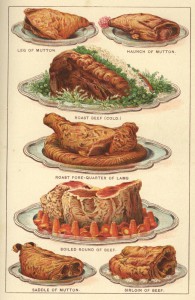Monday next will bring St. Bartholomew’s Day, the day of the traditional printer’s wayzgoose, this is a big day for book artists like me: St. Bartholomew is a patron saint of bookbinders and book artists and his day has been of significance to printers and papermakers, as well, for centuries. Goose is one traditional meal for the day, as is cheese, for St. Bart is also a patron saint of cheesemakers. But so is Bartlemas Beef, which takes some time to prepare… hence today’s post, designed to give you the time necessary to prepare a proper meal for your Wayzgoose Monday.
This recipe for a Rare Bartlemas Beef is taken from The Cook’s Guide by Hannah Wolley, printed in London in 1664. (The book’s full title is quite long: The Cook’s Guide: or, Rare receipts for cookery Published and set forth particularly for ladies and gentlewomen; being very beneficial for all those that desire the true way of dressing all sorts of flesh, fowles, and fish; the best directions for all manner of kickshaws, and the most ho-good sawces: whereby noble persons and others in their hospitalities may be gratified in their gusto’s. Phew. Perhaps the first celebratory printer’s wayzgoose came about once the typesetter triumphantly finished setting the type for this long-winded title.)
Lady Wolley calls this beef “rare” meaning fine or good. It does not refer to the cooking temperature. Judging by the three days soaking, she means for us to use salted beef, but that was 1664 and this is not and I think we can begin with fresh beef at the second step of her recipe, where the vinegar and wine is introduced. Be that as it may, here is her full 1664 recipe for a Rare Bartlemas Beef:
Take a fat Brisket piece of beef and bone it, put it into so much water as will cover it, shifting it three times a day for three dayes together, then put it into as much white wine and vinegar as will cover it, and when it hath lyen twenty-four hours take it out and drye it in a cloth, then take nutmeg, ginger, cinnamon, cloves and mace, of each a like quantity, beaten small and mingled with a good handful of salt, strew both sides of the Beef with this, and roul it up as you do Brawn, tye it as close as you can; then put it into an earthen pot, and cover it with some paste; set it in the Oven with household bread, and when it is cold, eat it with mustard and sugar.
There you have it: an old old recipe for celebrating an old old holiday. The St. Bart’s Wayzgoose is not widely celebrated today, but, considering the current boom of interest in letterpress printing and book arts, perhaps it should be. Pass the mustard, please.
The image of several fancy cuts of meat is from another old cookbook (though not nearly as old as Hannah Wolley’s): Mrs. Beeton’s Cookery Book, 1901. Thank you to the University of Michigan Digital Library for the online version of The Cook’s Guide.

